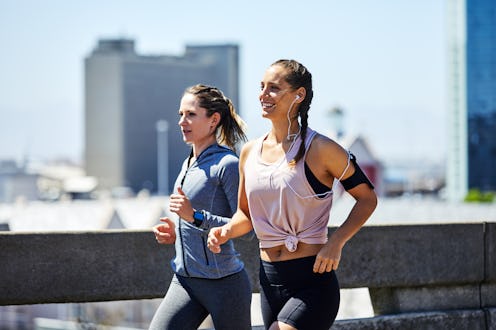Wellness
How To Create A Clean Air Running Route
Three steps to a low-pollution jog.

Running became an even more popular fitness activity this year as much of the country was forced to do their exercise outside. However, one downside of running, especially in large cities, is the potential to be exposed to the negative effects of rising air pollution levels. If you run in a built-up area full of fumes, you may want to consider adopting a clean running route. Thankfully, a bunch of technology now exists to help you embark on a low-pollution jog.
While pollution levels dramatically decreased during lockdown, air pollution has since returned to its pre-pandemic levels, says a new report. Environmental organisation Centre For Cities explained that as restrictions eased “the long-term impact of the pandemic may be to make pollution worse”.
So why should runners be concerned?
Research released in 2019 found that air pollution now kills more people than smoking. As the Evening Standard reports, almost nine million people die annually as a result of fine particles emitted from car exhausts, power plants, and factories.
In 2018, the World Health Organisation found that more than 40 towns and cities in the UK, including London, Swansea, and Manchester, had either reached or surpassed its air pollution limit of 10 micrograms per cubic metre. London has demonstrated some particularly shocking statistics. Per the BBC, pollution in the capital is thought to cause almost 10,000 deaths a year.
If you live in these areas, it's difficult, if not impossible, to avoid air pollution. But runners are breathing in around three times as much as the average walker, notes Vice. "The minute volume — the volume of air you breathe in in a minute — is hugely increased," Dr. Paul Cullinan, a professor at the National Heart and Lung Institute, told Vice. "I'm not saying the exposure would outweigh the benefits of the exercise, but if you're going to do the exercise, you're much better off doing it somewhere clean."
So here's a few ways to do just that.
Use an app
Certain elements of clean running are obvious. Swap areas with lots of traffic for green spaces and try to run at times when air pollution levels are lower i.e. not during rush hour. But a couple of apps exist to help you plan the cleanest route possible.
Tenzing's Clean Air Tracker, created with the help of King's College London, uses existing running tool, Strava, to list clean running routes for those in London. As well as finding a better route, the app calculates the air quality score of your usual routes.
Tenzing's tool is limited to London, but Geme.io works in towns and cities. It provides up-to-date air quality information for your local area and can alert you of places to avoid. Although you'll have to do a little more work to plan a jogging route, its virtual map is super easy to navigate.
Invest in a wearable device
If you don't mind splashing some cash, Plume Labs has invented a compact wearable device that measures your daily air quality. The Flow tracker links to an app to let you know how polluted your everyday life is. Again, you will have to use the data to work out your own running route, but it's an efficient and accurate way to make simple, healthier changes.
Costing £139, it even gives you an indicator of how polluted your current location is, explains Which. A green light signifies a low level of pollution, yellow means medium, red is pretty polluted, and purple indicates a heavy level. According to the company, Flow is the "only personal sensor to measure nitrous oxides (NO2) caused by exhaust gases."
Team up with other runners
Involving yourself in a running group makes planning a clean route so much quicker and easier. Each week, Tenzing holds a free Clean Air Run Club. Lasting between 7km and 10km, it takes place in London every Thursday at 6:30 p.m. More information can be found here.
If you can't find a local running group with an environmental slant, why not start your own? Put the word out on social media, and you're guaranteed to have a show of hands. If coronavirus restrictions permit, alternatively, you can join your nearest running club and bring up clean running. The idea is likely to be a popular one, no matter where you live.
This article was originally published on